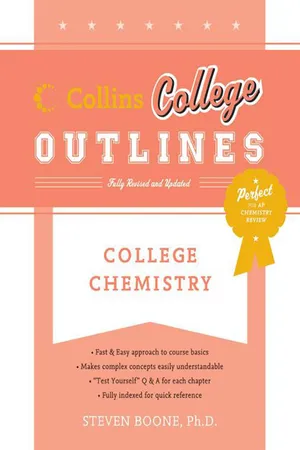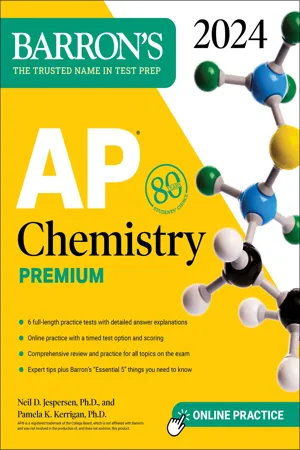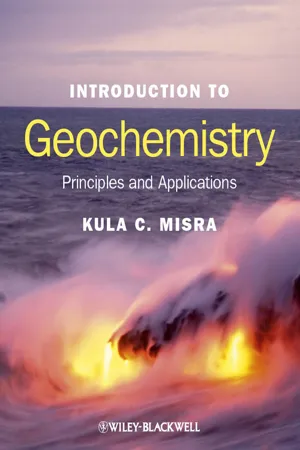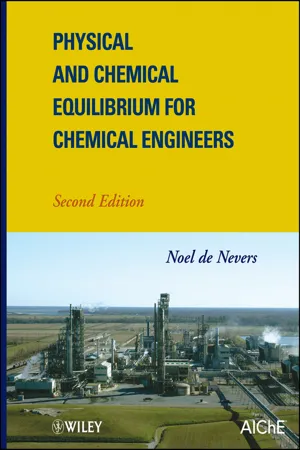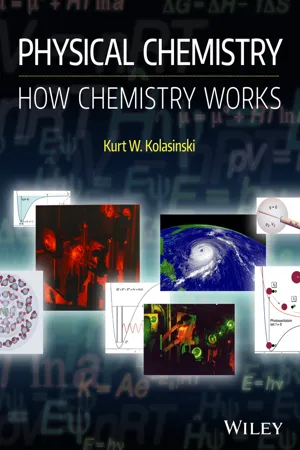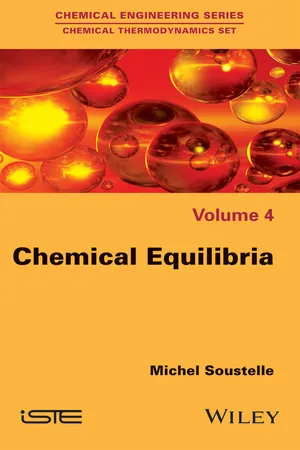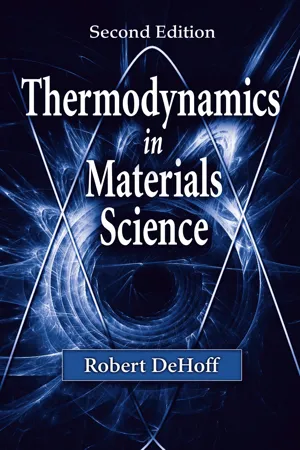Chemistry
Dynamic Equilibrium
Dynamic equilibrium in chemistry refers to a state where the rate of the forward reaction is equal to the rate of the reverse reaction, resulting in no net change in the concentrations of the reactants and products. While the concentrations remain constant, the individual reactions continue to occur. This state is characterized by a balance between the opposing processes, maintaining stability over time.
Written by Perlego with AI-assistance
Related key terms
10 Key excerpts on "Dynamic Equilibrium"
- eBook - ePub
- Adrian Dingle, Derrick C. Wood(Authors)
- 2014(Publication Date)
- Research & Education Association(Publisher)
PART VIIEQUILIBRIUM
Passage contains an image
Chapter 23
Dynamic Equilibrium
A. Dynamic Equilibrium: Physical, Biological, Environmental, and Chemical 1. Many chemical reactions are reversible. 2. Many biological and environmental examples of equilibrium exist, such as oxygen binding to, and being released from, hemoglobin, and the carbon cycle.I. Equilibrium3. Physical examples include the evaporation and condensation of H2 O.4. Chemical examples include the exchange of H+ ions in acid base reactions, and the exchange of electrons in REDOX reactions.5. Double arrows indicate reversibility of the reaction ( ).B. Equilibrium Conditions 1. At equilibrium, both reactants and products are present. 2. The forward reaction is favored when the concentration of reactants is high, and, hence, the rate of conversion of reactants to products is high. 3. The backward reaction is favored when the concentration of products is high, and, hence, the rate of conversion of products to reactants is high. 4. Dynamic Equilibrium is reached when the forward and backward reactions continue at the same rate, and the concentrations of the reactants and products are constant.Constant concentration of reactants and products does not necessarily mean identical concentrations of reactants and products. In fact, they are very rarely the same numerical value.All concentrations being constant (not changing) is not the same thing as concentrations being equal (all having the same value). This is a common misconception and one that you must not have. - No longer available |Learn more
- Steven Boone, Drew H. Wolfe(Authors)
- 2011(Publication Date)
- Collins Reference(Publisher)
CHAPTER 15Introduction to Chemical Equilibria
Chemical equilibrium systems are more resistant to change than those that are not in equilibrium. When an equilibrium system is disturbed, it responds in order to reestablish a state of equilibrium.15.1 THE EQUILIBRIUM STATEChemical reactions proceed spontaneously until they reach a state of Dynamic Equilibrium. At equilibrium, the rate of the forward reaction equals the rate of the reverse reaction. At this point, the reactant and product concentrations remain constant.Forward and Reverse ReactionsArrows that point in opposite directions, , show that an equilibrium has established. For example, the following equation is written for the equilibrium of H2 and CO2 with CO and H2 O.H2 (g) + CO2 (g) CO(g) + H2 O(g)The reaction that goes from left to right is the forward reaction, and the reaction that goes from right to left is the reverse reaction. Establishing Equilibrium Consider the following model reaction as it establishes equilibrium.H2 (g) + CO2 (g) → CO(g) + H2 O(g)When H2 and CO2 mix at constant temperature in a reaction vessel, they combine and begin to form the products, CO and H2 O. Hence, the concentrations of H2 and CO2 decrease, and the concentrations of CO and H2 O increase. As the reactant concentrations decrease, the rate of the forward reaction decreases and the rate of the reverse reaction increases. At some point, the rate of the forward reaction equals the rate of the reverse reaction and a chemical equilibrium establishes. After this time, the concentrations of the reactants and products do not change.The Equilibrium Constant ExpressionAn important quantitative relationship exists between the concentrations of the reactants and products. This relationship was identified by Cato Maxmilian Guldberg and Peter Waage in 1864 when they proposed the Law of Mass Action that expresses the equilibrium concentrations of the reactants and products in terms of an equilibrium constant expression (equilibrium expression - No longer available |Learn more
- Neil D. Jespersen, Pamela Kerrigan(Authors)
- 2023(Publication Date)
- Barrons Educational Services(Publisher)
PART 4Physical Chemistry
Passage contains an image
9
Chemical Equilibrium
Learning Objectives
In this chapter, you will learn:➔Chemical equilibrium ➔Dynamic Equilibrium ➔Equilibrium expression ➔Law of mass action ➔Equilibrium constant➔Kc , kp , ka , kb , ks p , kf➔Manipulating the equilibrium expression ➔Thermodynamically favorable reactions ➔Extent of reaction➔Reaction quotient, Q➔Equilibrium calculations➔Determination of K➔Solubility product ➔Le Châtelier’s principleThe concept of a Dynamic Equilibrium is central to many aspects of chemistry. In a Dynamic Equilibrium, chemicals are reacting rapidly at the molecular scale, while their concentrations remain constant on the macroscopic scale.Figure 9.1 shows that a chemical reaction has two well-defined regions in time, and these regions are studied and measured in very different ways. When compounds are first mixed in a chemical reaction, they interact to form other compounds. During the reaction process, the concentrations of the reactants decrease and the concentrations of the products increase. While the concentrations are changing, the reaction is studied using the principles of chemical kinetics, which are reviewed in Chapter 10 . At some point in time, the concentrations of the reactants and products stop changing. Although reactions do not stop at the molecular level, at the macroscopic level the concentrations of compounds in a Dynamic Equilibrium remain constant. At this point, the compounds are in a dynamic chemical equilibrium with each other, and they are studied and described using the concepts of chemical equilibrium.Figure 9.1 - eBook - ePub
Chemistry
With Inorganic Qualitative Analysis
- Therald Moeller(Author)
- 2012(Publication Date)
- Academic Press(Publisher)
Section 25.6 .)Reactions in the gas phase are particularly easy to study as examples of equilibrium. Suppose some nitrogen dioxide, NO2 , is confined in a closed vessel of fixed volume at a constant temperature. Immediately, the formation of dinitrogen tetroxide, N2 O4 , begins. We choose to call this the “forward” reaction:As soon as some N2 O4 has formed the “reverse” reaction begins—the breakdown of N2 O4 molecules to give NO2 molecules. The rates of the forward and reverse reactions and the amounts of the two gases continue to change until equilibrium is reached. At this point the “opposing forces”—the forward and reverse reactions—are balanced.The forward and reverse reactions proceed at equal rates, with the net result that the amounts of the two gases are constant. It is a dynamic state. Each time an N2 O4 molecule is formed, two molecules of NO2 disappear; each time an N2 O4 molecule decomposes, two new NO2 molecules appear. As long as the temperature and pressure remain constant and nothing is added to or taken from the mixture, the equilibrium state remains unchanged.What happens if we pump more NO2 molecules into the vessel? With more NO2 available, whatever collisions precede the formation of N2 O4 occur more often. If the formation of N2 O4 proceeds faster than its decomposition, the amount of N2 O4 increases. As the concentration of N2 O4 increases, the rate of its decomposition also increases. Changes in the concentrations and in the forward and reverse reaction rates continue until equilibrium has been reached once more (Figure 16.1 - eBook - ePub
Introduction to Geochemistry
Principles and Applications
- Kula C. Misra(Author)
- 2012(Publication Date)
- Wiley-Blackwell(Publisher)
This rearrangement of atoms from one configuration to another is called a chemical reaction. It is possible that the forward reaction X + Y → C + D will result in complete conversion of X and Y into C and D. Many chemical reactions, however, remain incomplete because of the reverse reaction C + D → X + Y. The reaction is considered to have attained chemical equilibrium if and when the rate of the forward reaction becomes equal to the rate of the reverse reaction. If conditions of the experiment remain unchanged, then at equilibrium all the four substances would coexist without any further change in their concentrations with time. For a chemical reaction, the terms reversibility and equilibrium are often used interchangeably because a reversible process is conceptualized as a process that proceeds in such infinitely small steps that the system is at equilibrium for every step. Real geochemical systems seldom, if ever, attain a state of equilibrium, but the equilibrium model, because of its simple mathematical relationships, serves as a useful reference for evaluating chemical reactions. An irreversible chemical reaction is unidirectional and so can never achieve equilibrium. A reaction may also not attain equilibrium either because the rate of the forward or the reverse reaction is too slow or because one or more of the products are removed from the system. If a chemical reaction occurs as written at the molecular level (i.e., without involving intermediate steps), then its rate is proportional to the concentrations of the reacting substances (see Chapter 9 for a more elaborate discussion of rates of chemical reactions) - eBook - ePub
- Jeffrey Gaffney, Nancy Marley(Authors)
- 2017(Publication Date)
- Elsevier(Publisher)
Chapter 7Chemical Equilibrium
Abstract
This chapter reviews the principles of chemical equilibrium beginning with the concept that many chemical reactions are reversible. These reversible reactions achieve a Dynamic Equilibrium where the rate of the forward reaction equals the rate of the reverse reaction. This Dynamic Equilibrium is described by an equilibrium constant, which is determined from the concentrations of the reactants and products at equilibrium. The magnitude of the equilibrium constant is presented as measure of the extent that the forward and reverse reactions take place. Le Chatelier's principle is introduced and the changes in reaction conditions that can disturb a chemical equilibrium are reviewed. The response of the chemical reaction to these changes in reaction conditions is explained in detail. The reaction quotient is presented as a means of determining the direction the reaction is likely to proceed.Keywords
Reversible reactions; Dynamic Equilibrium; Equilibrium constant; Partial pressures; Le Chatelier's principle; Exothermic; Endothermic; Reaction quotientOutline7.1Reversible Reactions7.2The Equilibrium Constant7.3Relationships Between Equilibrium Constants7.4Le Chatelier's Principle: Disturbing a Chemical Equilibrium7.5The Reaction QuotientImportant TermsStudy QuestionsProblems7.1 Reversible Reactions
The idea that a chemical reaction can be reversible was introduced by Claude Louis Berthollet in 1803 when he observed the formation of sodium carbonate crystals at the edge of a limestone salt lake in Egypt (Fig. 7.1 ). Since the salt lake was a landlocked body of water with a very high concentration of dissolved sodium chloride (> 3 g/L) and other minerals, he knew that the formation of these crystals must be a result of the following chemical reaction;Fig. 7.1 - Noel de Nevers(Author)
- 2012(Publication Date)
- Wiley(Publisher)
Chapter 12 Chemical Equilibrium12.1 Introduction to Chemical Reactions and Chemical EquilibriumChemical reactions transform one chemical species or set of species to another species or set of species: reactant(s) → product(s). Sometimes we do this because the products (e.g., pharmaceuticals) are much more valuable than the reactants from which they are made. Sometimes we want the heat released by the chemical reaction of the materials (e.g., fuels) with air (burning) either to heat some material (cooking our food or heating our homes) or to burn the fuels inside the engines that propel our vehicles or generate electricity. Sometimes we destroy harmful materials by chemical reaction (incineration of hazardous hydrocarbons, destruction of bacteria, protozoa, and viruses in drinking water with chlorine or ozone). The most important chemical reactions are those within our bodies. Every second millions of chemical reactions are occurring in our bodies, accomplishing all the things we call life. The chemical reactions in our nervous system control our muscular movements and our thoughts; the nerve gases that interfere with those chemical reactions can kill in seconds.In this chapter we consider only single chemical reactions, all occurring in one phase. In the next chapter we consider multiple reactions, in series and in parallel, occurring in one or more phases. The next chapter introduces no new principles, only more complex and interesting applications of the ideas of this chapter.- eBook - ePub
Physical Chemistry
How Chemistry Works
- Kurt W. Kolasinski(Author)
- 2016(Publication Date)
- Wiley(Publisher)
CHAPTER 11 Chemical equilibriumPREVIEW OF IMPORTANT CONCEPTS
- Any system held at constant temperature and constant volume will evolve until its Helmholtz energy is a minimum.
- Any system held at constant temperature and constant pressure will evolve until its Gibbs energy is a minimum.
- The Gibbs energy change is directly related to enthalpy and entropy changes by Δr G = Δr H − TΔr S.
- The standard Gibbs energy of reaction is related to the equilibrium constant by Δr G°m = −RTln K.
- Both the Gibbs energy change and the equilibrium constant are inherently temperature-dependent.
- The chemical potential of a pure substance is its molar Gibbs energy.
- At equilibrium the chemical potential is the same everywhere in a container for all species in the container.
- A system at equilibrium, when subjected to a disturbance, responds in a way that tends to minimize the effect of the disturbance.
- All ionic solids are assumed to be fully dissociated at infinite dilution but precipitate at the point at which the chemical potential of the solid is lower than that of the solvated ions. This point is when the reaction quotient exceeds the solubility product.
As stated by the IUPAC, equilibrium is the state of a system in which the macroscopic properties of each phase of the system become uniform and independent of time. If the temperature is uniform throughout the system, a state of thermal equilibrium has been reached; if the pressure is uniform, a state of hydrostatic equilibrium has been reached; and if the chemical potential of each component is uniform, a state of chemical equilibrium has been reached. If all of these quantities become uniform the system is said to be in a state of complete thermoDynamic Equilibrium.11.1 Chemical potential and Gibbs energy of a reaction mixture
The chemical potential of a pure substance is defined as(11.1)In words, the chemical potential shows how the Gibbs energy of a system changes as a substance is added to it. For a pure substance, the Gibbs energy is simply G = nGm - eBook - ePub
- Michel Soustelle(Author)
- 2015(Publication Date)
- Wiley-ISTE(Publisher)
the two systems A and B are thermodynamically equivalent. We can even state that the second system, B, is closer to equilibrium than system A.The concept of thermodynamically-equivalent systems is used, in particular, when studying sets of several reactions, using the predominant-reaction method. The method is very frequently used for calculating the state of equilibrium of ionic reactions in an aqueous solution – e.g. calculating the pH of a solution.2.6. Stability of equilibria
The concept of stability of a state of equilibrium is a relative notion. That stability is understood in relation to a specific transformation. For example, if we take oxygenated water at standard temperature and pressure (STP), we know that this substance is unstable in terms of water but is stable in terms of the hydrogen–oxygen mixture.2.6.1. De Donder’s general stability condition
Consider a system S defined by the chosen values of the intensive variables and by an extent ξ of the transformation envisaged (ξ can be null). The values of the different physical intensive variables are kept constant. If, at a given time, that system is at equilibrium, it is because its rate S is null. At the same time, imagine another system S’, identical to S except for its extent, which is ξ ’ = ξ + δξ. System S’ is said to be disturbed in relation to system S. It is generally not at equilibrium, and thus its rate S , is different to zero. δξ is called the disturbance.De Donder says that system S is stable in relation to the disturbance δξ if the rate of system S’ has the sign which tends to bring S’ back to state S.Hence if δξ > 0, then S , must be negative in order for system S to be stable. Conversely, if δξ < 0, then S , must be positive. This gives us the stability condition of S - eBook - ePub
- Robert DeHoff(Author)
- 2006(Publication Date)
- CRC Press(Publisher)
This thermodynamic externum principle (the entropy has an extreme value, a maximum) is then formulated mathematically. A set of equations, called the conditions for equilibrium, that describe the relationships that the internal properties of the isolated system must have when it achieves its equilibrium state are derived from this extremum principle. It is then demonstrated that although these conditions for equilibrium are derived for an isolated system, they are valid for any system at equilibrium whether or not it was isolated during its approach to that final condition.The strategy for obtaining these conditions for equilibrium is illustrated in this chapter by applying it to the simplest case: equilibrium in a unary, two-phase system.This strategy is applied repeatedly in subsequent chapters to derive the conditions for equilibrium in systems of progressively increasing sophistication. These equations are the basis for making practical calculations about the final resting condition of complex systems.The chapter ends with a collection of alternate statements of the criterion for equilibrium, each of which is useful in the description of systems with specific external constraints.5.1 INTUITIVE NOTIONS OF EQUILIBRIUM
The idea that a system changes toward some final ultimate condition and, once there, remains in that condition unless acted upon by some external agent is a familiar one. Such a system is said to come to equilibrium or approach its equilibrium state. The specific nature of that state depends upon the chemical and energy content of the system and that of its surroundings. A system comes to equilibrium in given surroundings. It may only be disturbed from its equilibrium state by changing the state of its surroundings.A simple application of this idea is illustrated in Figure 5.1
Index pages curate the most relevant extracts from our library of academic textbooks. They’ve been created using an in-house natural language model (NLM), each adding context and meaning to key research topics.

